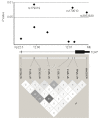TLR7 single-nucleotide polymorphisms in the 3' untranslated region and intron 2 independently contribute to systemic lupus erythematosus in Japanese women: a case-control association study
- PMID: 21396113
- PMCID: PMC3132023
- DOI: 10.1186/ar3277
TLR7 single-nucleotide polymorphisms in the 3' untranslated region and intron 2 independently contribute to systemic lupus erythematosus in Japanese women: a case-control association study
Abstract
Introduction: The Toll-like receptor 7 (TLR7) gene, encoded on human chromosome Xp22.3, is crucial for type I interferon production. A recent multicenter study in East Asian populations, comprising Chinese, Korean and Japanese participants, identified an association of a TLR7 single-nucleotide polymorphism (SNP) located in the 3' untranslated region (3' UTR), rs3853839, with systemic lupus erythematosus (SLE), especially in males, although some difference was observed among the tested populations. To test whether additional polymorphisms contribute to SLE in Japanese, we systematically analyzed the association of TLR7 with SLE in a Japanese female population.
Methods: A case-control association study was conducted on eight tag SNPs in the TLR7 region, including rs3853839, in 344 Japanese females with SLE and 274 healthy female controls.
Results: In addition to rs3853839, two SNPs in intron 2, rs179019 and rs179010, which were in moderate linkage disequilibrium with each other (r2 = 0.53), showed an association with SLE (rs179019: P = 0.016, odds ratio (OR) 2.02, 95% confidence interval (95% CI) 1.15 to 3.54; rs179010: P = 0.018, OR 1.75, 95% CI 1.10 to 2.80 (both under the recessive model)). Conditional logistic regression analysis revealed that the association of the intronic SNPs and the 3' UTR SNP remained significant after we adjusted them for each other. When only the patients and controls carrying the risk genotypes at the 3' UTR SNP position were analyzed, the risk of SLE was significantly increased when the individuals also carried the risk genotypes at both of the intronic SNPs (P = 0.0043, OR 2.45, 95% CI 1.31 to 4.60). Furthermore, the haplotype containing the intronic risk alleles in addition to the 3' UTR risk allele was associated with SLE under the recessive model (P = 0.016, OR 2.37, 95% CI 1.17 to 4.80), but other haplotypes were not associated with SLE.
Conclusions: The TLR7 intronic SNPs rs179019 and rs179010 are associated with SLE independently of the 3' UTR SNP rs3853839 in Japanese women. Our findings support a role of TLR7 in predisposition for SLE in Asian populations.
Figures


References
Publication types
MeSH terms
Substances
LinkOut - more resources
Full Text Sources
Medical

